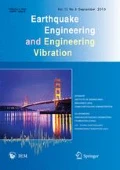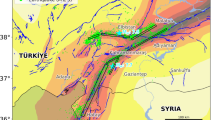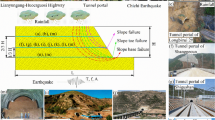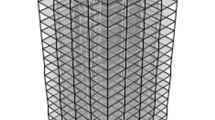Abstract
Although intensive research of the influence of ground motion duration on structural cumulative damage has been carried out, the influence of dynamic responses in underground tunnels remains a heated debate. This study attempts to highlight the importance of the ground motion duration effect on hydraulic tunnels subjected to deep-focus earthquakes. In the study, a set of 18 recorded accelerograms with a wide-range of durations were employed. A spectrally equivalent method serves to distinguish the effect of duration from other ground motion features, and then the seismic input model was simulated using SV-wave excitation based on a viscous-spring boundary, which was verified by the time-domain waves analysis method. The nonlinear analysis results demonstrate that the risk of collapse of the hydraulic tunnel is higher under long-duration ground motion than that of short-duration ground motion of the same seismic intensity. In a low intensity earthquake, the ground motion duration has little effect on the damage energy consumption of a hydraulic tunnel lining, but in a high intensity earthquake, dissipation of the damage energy and damage index of concrete shows a nonlinear growth trend accompanied by the increase of ground motion duration, which has a great influence on the deformation and stress of hydraulic tunnels, and correlation analysis shows that the correlation coefficient is greater than 0.8. Therefore, the duration of ground motion should be taken into consideration except for its intensity and frequency content in the design of hydraulic tunnel, and evaluation of seismic risk.
Similar content being viewed by others
References
Abedi-Nik F and Khoshnoudian F (2014), “Evaluation of Ground Motion Scaling Methods in Soil-Structure Interaction Analysis,” The Structural Design of Tall Special Buildings, 23(1): 54–66.
Álamo GM, Padrón LA, Aznárez JJ and Maeso O (2015), “Structure-Soil-Structure Interaction Effects on the Dynamic Response of Piled Structures Under Obliquely Incident Seismic Shear Waves,” Soil Dynamics and Earthquake Engineering, 78: 142–153.
Archuleta RJ, Steidl J and Squibb M (2006), “The COSMOS Virtual Data Center: A Web Portal for Strong Motion Data Dissemination,” Seismological Research Letters, 77(6): 651–658.
Arjun CR and Kumar A (2011), “Neural Network Estimation of Duration of Strong Ground Motion Using Japanese Earthquake Records,” Soil Dynamics Earthquake Engineering, 31(7): 866–872.
Bolt BA (1973), “Duration of Strong Ground Motion,” In: Proceedings of the 5th World Conference on Earthquake Engineering, pp: 1304–1313.
Bommer JJ (1999), “The Effective Duration of Earthquake Strong Motion,” Journal of Earthquake Engineering, 3(02): 127–172.
Bommer JJ, Hancock J, Alarcón JE and Engineering E (2006), “Correlations Between Duration and Number of Effective Cycles of Earthquake Ground Motion,” Soil Dynamics Earthquake Engineering, 26(1): 1–13.
Bommer JJ, Magenes G, Hancock J and Penazzo P (2004), “The Influence of Strong-Motion Duration on the Seismic Response of Masonry Structures,” Bulletin of Earthquake Engineering, 2(1): 1–26.
Bommer JJ, Stafford PJ and Alarcón JE (2009), “Empirical Equations for the Prediction of the Significant, Bracketed, and Uniform Duration of Earthquake Ground Motion,” Bulletin of the Seismological Society of America, 99(6): 3217–3233.
Bracci JM, Reinhorn AM, Mander JB and Kunnath SK (1989), “Deterministic Model for Seismic Damage Evaluation of Reinforced Concrete Structures,” Technical Report NCEER-89-0033, National Center for Earthquake Engineering Research, State University of New York at Buffalo.
Chandramohan R, Baker JW and Deierlein GG (2016), “Quantifying the Influence of Ground Motion Duration on Structural Collapse Capacity Using Spectrally Equivalent Records,” Earthquake Spectra, 32(2): 927–950.
Chaulagain H, Rodrigues H, Varum H, Silva V and Gautam D (2017), “Generation of Spectrum-Compatible Acceleration Time History for Nepal,” Comptes Rendus Geoscience, 349(5): 198–201.
Chen Z and Wei J (2012), “Correlation Between Ground Motion Parameters and Lining Damage Indices for Mountain Tunnels,” Natural Hazards, 65(3): 1683–1702.
Chiou B, Darragh R, Gregor N and Silva W (2008), “NGA Project Strong-Motion Database,” Earthquake Spectra, 24(1): 23–44.
Davis C, Lee V and Bardet J (2001), “Transverse Response of Underground Cavities and Pipes to Incident SV Waves,” Earthquake Engineering and Structural Dynamics, 30(3): 383–410.
Deeks AJ and Randolph MF (1994), “Axisymmetric Time-Domain Transmitting Boundaries,” Journal of Engineering Mechanics, 120(1): 25–42.
Deeks AJ and Wolf JP (2002), “A Virtual Work Derivation of the Scaled Boundary Finite-Element Method for Elastostatics,” Computational Mechanics, 28(6): 489–504.
Du X and Zhao M (2010a), “A Local Time-Domain Transmitting Boundary for Simulating Cylindrical Elastic Wave Propagation in Infinite Media,” Soil Dynamics and Earthquake Engineering, 30(10): 937–946.
Du X and Zhao M (2010b), “Stability and Identification for Rational Approximation of Frequency Response Function of Unbounded Soil,” Earthquake Engineering and Structural Dynamics, 39(2): 165–186.
Fibich G and Tsynkov S (2001), “High-Order Two-Way Artificial Boundary Conditions for Nonlinear Wave Propagation with Backscattering,” Journal of Computational Physics, 171(2): 632–677.
Foschaar JC, Baker JW and Deierlein GG (2012), “Preliminary Assessment of Ground Motion Duration Effects on Structural Collapse,” Cigr Proceeding.
Greco R, Marano GC, Foti DJPASM and Applications I (1999), “Strong Motion Duration Effects on Base Isolated Systems,” Physica A Statistical Mechanics Its Applications, 274(1–2): 341–348.
Guan Huimin (1996), “A Method for the Stability Analysis of Local Artificial Boundaries,” Acta Mechanica Sinica, 12: 376–380. (in Chinese)
Guan Huimin (1997), “A Summary on the Methods for the Stability Analysis of Artificial Local Boundaries in Time Domain,” World Information on Earthquake Engineering. (in Chinese)
Halpern L (1991), “Artificial Boundary Conditions for Incompletely Parabolic Perturbations of Hyperbolic Systems,” Journal on Mathematical Analysis, 22(5): 1256–1283.
Halpern L and Schatzman M (1989), “Artificial Boundary Conditions for Incompressible Viscous Flows,” Journal on Mathematical Analysis, 20(2): 308–353.
Hancock J and Bommer JJ (2007), “Using Spectral Matched Records to Explore the Influence of Strong-Motion Duration on Inelastic Structural Response,” Soil Dynamics and Earthquake Engineering, 27(4): 291–299.
Hancock J and Bommer JJ (2012), “A State-of-Knowledge Review of the Influence of Strong-Motion Duration on Structural Damage,” Earthquake Spectra, 22(3): 827–845.
Huang J, Zhao M and Du X (2017a), “Nonlinear Seismic Responses of Tunnels Within Normal Fault Ground Under Obliquely Incident P Waves,” Tunnelling and Underground Space Technology, 61: 26–39.
Huang JQ, Du XL, Zhao M and Zhao X (2017b), “Impact of Incident Angles of Earthquake Shear (S) Waves on 3-D Nonlinear Seismic Responses of Long Lined Tunnels,” Engineering Geology, 222: 168–185.
Huang JQ, Xiu-Li DU, Tian ZM, Jin L and Zhao M (2014), “Effect of the Oblique Incidence of Seismic SV Waves On The Seismic Response of Subway Station Structure,” Engineering Mechanics, 31(9): 81–88.
Hull AJ (1992), “A Closed Form Solution of a Longitudinal Bar with a Viscous Boundary Condition,” Journal of Sound Vibration, 169: 22.
Hushmand A, Dashti S, Davis C, McCartney JS, Hushmand BJSD and Engineering E (2016), “A Centrifuge Study of the Influence of Site Response, Relative Stiffness, and Kinematic Constraints on the Seismic Performance of Buried Reservoir Structures,” Soil Dynamics and Earthquake Engineering, 88: 427–438.
Husid R (1969), “Analisis de Terremoros: Analisis General Rev,” IDIEM, 8: 21–42.
Iervolino I, Manfredi G and Cosenza EJEE (2010), “Ground Motion Duration Effects on Nonlinear Seismic Response,” Earthquake Engineering and Structural Dynamics, 35(1): 21–38.
Jayaram N, Lin T and Baker JW (2011), “A Computationally Efficient Ground-Motion Selection Algorithm for Matching a Target Response Spectrum Mean and Variance,” Earthquake Spectra, 27(3): 797–815.
Jiao YY, Zhang XL, Zhao J, Liu QS and Sciences M (2007), “Viscous Boundary of DDA for Modeling Stress Wave Propagation in Jointed Rock,” International Journal of Rock Mechanics, 9(44): 1070–1076.
Kalkan E and Chopra AK (2010), “Practical Guidelines to Select and Scale Earthquake Records for Nonlinear Response History Analysis of Structures,” US Geological Survey Open-File Report, 1068: 126.
Kampas G, Knappett JA, Brown MJ, Anastasopoulos I, Fuentes R, Nikitas N and Alonso-Rodriguez (2018), “A Suitability of Equivalent Linear Soil Models for Analysing the Seismic Response of a Concrete Tunnel,” In: European Conference in Earthquake Engineering.
Lee J and Fenves GL (1998), “Plastic-Damage Model for Cyclic Loading of Concrete Structures,” Journal of Engineering Mechanics, 124(8): 892–900.
Lee V and Karl J (1992), “Diffraction of SV Waves by Underground, Circular, Cylindrical Cavities,” Soil Dynamics and Earthquake Engineering, 11(8): 445–456.
Lee VW and Karl J (1993), “On Deformation Near a Circular Underground Cavity Subjected to Incident Plane P Waves,” European Journal of Earthquake Engineering, 7: 29–36.
Liu Jingbo, Shu L and Du X (1999), “A Method for the Analysis of Dynamic Response of Structure Containing Non-Smooth Contactable Interfaces,” Acta Mechanica Sinica, 15(1): 63–72.
Liu JB, Du YX and Du X (2006), “3D Viscous-Spring Artificial Boundary in Time Domain,” Earthquake Engineering and Engineering Vibration, 5(1): 93–102.
Liu Jingbo, Wang Zhenyu and Du Xiuli (2005), “Three-Dimensional Visco-Elastic Artificial Boundaries in Time Domain for Wave Motion Problems,” Engineering Mechanics, 22: 46–51. (in Chinese)
Liu Yunhe, Zhang Boyan and Chen Houqun (2006), “Comparison of Spring-Viscous Boundary with Viscous Boundary for Arch Dam Seismic Input Model,” Journal of Hydraulic Engineering, 37: 758–763. (in Chinese)
Lubliner J, Oliver J, Oller S and Oñate E (1989), “A Plastic-Damage Model for Concrete,” International Journal of Solids Structures, 25: 299–326.
Luco J E and F C P De Barros (1994), “Seismic Response of a Cylindrical Shell Embedded in a Layered Viscoelastic Half-Space. I: Formulation,” Earthquake engineering and structural dynamics, 23(5): 553–567.
Lysmer J and Kuhlemeyer RL (1969), “Finite Dynamic Model for Infinite Media,” Journal of the Engineering Mechanics Division, 95(4): 859–878.
Montejo LA and Kowalsky MJ (2008), “Estimation of Frequency-Dependent Strong Motion Duration Via Wavelets and Its Influence on Nonlinear Seismic Response,” Computer-Aided Civil Infrastructure Engineering, 23(4): 253–264.
Naeim F and Lew M (2012), “On the Use of Design Spectrum Compatible Time Histories,” Earthquake Spectra, 11(1): 111–127.
Ohtsuki A and Harumi K (2010), “Effect of Topography and Subsurface Inhomogeneities on Seismic SV Waves,” Earthquake Engineering and Structural Dynamics, 11(4): 441–462.
Ou YC, Song J, Wang PH, Adidharma L, Chang KC and Lee GCJ (2014), “Ground Motion Duration Effects on Hysteretic Behavior of Reinforced Concrete Bridge Colums,” Journal of Structural Engineering, 140(3): 04013065.
Oskouei AG and Oskouei AV (2017), “The effect of P-Wave Propagation on the Seismic Behavior of Steel Pipelines,” Periodica Polytechnica Civil Engineering, 61(4): 889–903.
Park YJ and Ang HS (1985), “Mechanistic Seismic Damage Model for Reinforced Concrete,” Journal of Structural Engineering, 111(4): 722–739.
Raghunandan M and Liel AB (2013), “Effect of Ground Motion Duration on Earthquake-Induced Structural Collapse,” Structural Safety, 41: 119–133.
Ranf RT, Eberhard MO and Berry MP (2001), “Pacific Earthquake Engineering Research Center,” Roufailel MSL (1987), “Reliability of Concrete Frames Damaged by Earthquakes,” Journal of Structural Engineering, 113(3): 445–457.
Towhata I (2008), “Geotechnical Earthquake Engineering,” Springer Science and Business Media.
Trifunac MD and Brady AG (1975), “A Study on the Duration of Strong Earthquake Ground Motion,” Bulletin of the Seismological Society of America, 65(3): 581–626.
Wang C, Hao H, Zhang S and Wang G (2018), “Influence of Ground Motion Duration on Responses of Concrete Gravity Dams,” Journal of Earthquake Engineering, 2018: 1–25.
Wang G, Wang Y, Lu W, Yan P, Zhou W and Chen MJ (2016), “A General Definition of Integrated Strong Motion Duration and Its Effect on Seismic Demands of Concrete Gravity Dams,” Engineering Structures, 125: 481–493.
Wang G, Wang Y, Lu W, Yu M and Wang C (2017), “Deterministic 3D Seismic Damage Analysis of Guandi Concrete Gravity Dam: A Case Study,” Engineering Structures, 148: 263–276.
Wang GQ, Zhou XY, Zhang PZ and Igel HJ (2002), “Characteristics of Amplitude and Duration for Near Fault Strong Ground Motion from the 1999 Chi-Chi, Taiwan Earthquake,” Soil Dynamics Earthquake Engineering, 22(1): 73–96.
Wong K, Shah A and Datta S (1985), “Diffraction of Elastic Waves in a Half-Space. II. Analytical and Numerical Solutions,” Bulletin of the Seismological Society of America, 75(1): 69–92.
Yu H, Chen J, Bobet A and Yuan Y (2016), “Damage Observation and Assessment of the Longxi Tunnel During the Wenchuan Earthquake,” Tunnelling and Underground Space Technology, 54: 102–116.
Yu H, Yuan Y, Chen Z, Yu G and Gu Y (2009), “Full 3D Numerical Simulation Method and Its Application to Seismic Response Analysis of Water-Conveyance Tunnel,” Computational Structural Engineering, 2009: 349–358.
Zarzalejos JM, Aznárez JJ, Padrón LA and Maeso O (2014), “Influences of Type of Wave and Angle of Incidence on Seismic Bending Moments in Pile Foundations,” Earthquake Engineering and Structural Dynamics, 43(1): 41–59.
Zhang HY, Zhang LJ, Wang HJ and Guan CN (2018), “Influences of the Duration and Frequency Content of Ground Motions on the Seismic Performance of High-Rise Intake Towers,” Engineering Failure Analysis, 91: 481–495.
Zhao M, Du X, Liu J and Liu H (2011), “Explicit Finite Element Artificial Boundary Scheme for Transient Scalar Waves in Two-Dimensional Unbounded Waveguide,” International Journal for Numerical Methods in Engineering, 87(11): 1074–1104.
Zhao M, Gao Z, Wang L, Du X, Huang J and Li Y (2017), “Obliquely Incident Earthquake for Soil-Structure Interaction in Layered Half Space,” Earthquakes and Structures, 13(06): 573–588.
Zhao M, Li H, Du X and Wang P (2018a), “Time-Domain Stability of Artificial Boundary Condition Coupled with Finite Element for Dynamic and Wave Problems in Unbounded Media,” International Journal of Computational Methods, 15(3): 1850099.
Zhao M, Wu L, Du X, Zhong Z, Xu C and Li L (2018b), “Stable High-Order Absorbing Boundary Condition Based on New Continued Fraction for Scalar Wave Propagation in Unbounded Multilayer Media,” Computer Methods in Applied Mechanics and Engineering, 334: 111–137.
Zhao M, Yin H, Du X, Liu J and Liang L (2015), “1D Finite Element Artificial Boundary Method for Layered Half Space Site Response from Obliquely Incident Earthquake,” Earthquakes and Structures, 9(01): 173–194.
Acknowledgment
The authors gratefully appreciate support from National Key Research and Development Program of China (No. 2018YFC0406903), Yunnan Key Research and Development Program (No. 2017IB014), and the Innovative Research Groups of the National Natural Science Foundation of China (No. 51621092).
Author information
Authors and Affiliations
Corresponding author
Additional information
Supported by
National Key Research and Development Program of China under Grant No. 2018YFC0406903, Yunnan Key Research and Development Program under Grant No. 2017IB014, and the Innovative Research Groups of the National Natural Science Foundation of China under Grant No. 51621092
Rights and permissions
About this article
Cite this article
Sun, B., Zhang, S., Wang, C. et al. Ground motion duration effect on responses of hydraulic shallow-buried tunnel under SV-waves excitations. Earthq. Eng. Eng. Vib. 19, 887–902 (2020). https://doi.org/10.1007/s11803-020-0602-x
Received:
Accepted:
Published:
Issue Date:
DOI: https://doi.org/10.1007/s11803-020-0602-x




